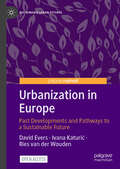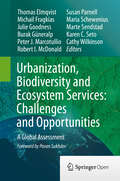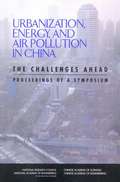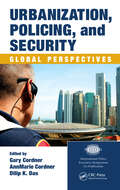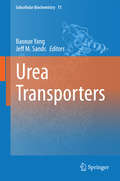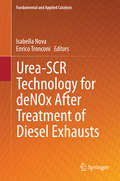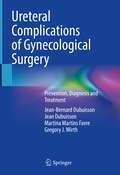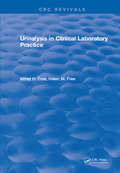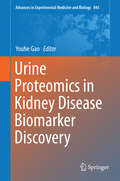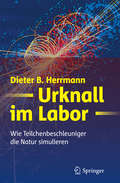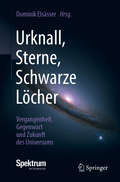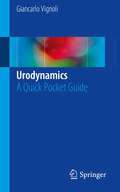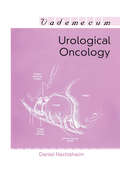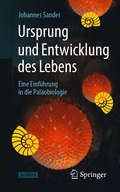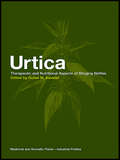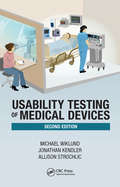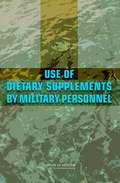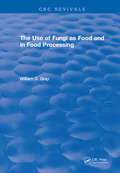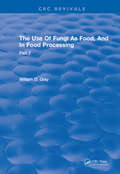- Table View
- List View
Urbanization in Europe: Past Developments and Pathways to a Sustainable Future (Sustainable Urban Futures)
by David Evers Ivana Katurić Ries van der WoudenThis open access book comes at an opportune time, with ‘land take’ high on the EU policy agenda. It shows how over one million hectares in Europe became urbanized between 2000 and 2018, over eight times that which changed back to agriculture or nature. This book seeks to explain this development and offer suggestions on how to control it, drawing on the ESPON Sustainable Urbanization and land-use Practices in European Regions (SUPER) project. It presents up-to-date analyses on urbanization rates (land take) as well as densities and morphology (sprawl). It also discusses the impact of spatial planning instruments and other public-sector interventions. Finally, the book peers into the future by drawing up urbanization scenarios – compact, polycentric, and diffuse – for 2050, and reflects on their sustainability. It concludes with the encouraging message that policy can make a positive difference.
Urbanization, Biodiversity and Ecosystem Services: Challenges and Opportunities
by Robert I. Mcdonald Michail Fragkias Burak Güneralp Thomas Elmqvist Julie Goodness Peter J. Marcotullio Susan Parnell Maria Schewenius Marte Sendstad Karen C. Seto Cathy WilkinsonUrbanization is a global phenomenon and the book emphasizes that this is not just a social-technological process. It is also a social-ecological process where cities are places for nature, and where cities also are dependent on, and have impacts on, the biosphere at different scales from local to global. The book is a global assessment and delivers four main conclusions: Urban areas are expanding faster than urban populations. Half the increase in urban land across the world over the next 20 years will occur in Asia, with the most extensive change expected to take place in India and China Urban areas modify their local and regional climate through the urban heat island effect and by altering precipitation patterns, which together will have significant impacts on net primary production, ecosystem health, and biodiversity Urban expansion will heavily draw on natural resources, including water, on a global scale, and will often consume prime agricultural land, with knock-on effects on biodiversity and ecosystem services elsewhere Future urban expansion will often occur in areas where the capacity for formal governance is restricted, which will constrain the protection of biodiversity and management of ecosystem services
Urbanization, Energy, And Air Pollution In China: The Challenges Ahead
by National Research Council Staff National Academy of Engineering Staff Chinese Academy of Engineering Staff Zhongguo Gong Cheng Yuan Staff Zhongguo Ke Xue Yuan Staff Chinese Academy of Sciences StaffIn October 2003, a group of experts met in Beijing under the auspices of the Chinese Academy of Sciences, Chinese Academy of Engineering, and National Academy of Engineering (NAE)/National Research Council (NRC) of the National Academies to continue a dialogue and eventually chart a rational course of energy use in China. This collection of papers is intended to introduce the reader to the complicated problems of urban air pollution and energy choices in China.
Urbanization, Policing, and Security: Global Perspectives (International Police Executive Symposium Co-Publications)
by Gary Cordner Dilip K. Das AnnMarie CordnerIn terms of raw numbers, the amount of world urban dwellers have increased four-fold, skyrocketing from 740 million in 1950 to almost 3.3 billion in 2007. This ongoing urbanization will continue to create major security challenges in most countries. Based on contributions from academics and practitioners from countries as diverse as Nigeria, Pakist
Urea Transporters
by Baoxue Yang Jeff M. SandsThe mechanisms and physiological functions of urea transporters across biological membranes are subjects of long-standing interests. Although urea represents roughly 40% of all urinary solutes in normal human urine, the handling of urea in the tissues has been largely neglected in the past and few clinical or experimental studies now report data on urea. Most recent physiological text books include chapters on water and electrolyte physiology but no chapter on urea. Our aim in writing this book is to stimulate further research in new directions by providing novel and provocative insights into the further mechanisms and physiological significance of urea metabolism and transport in mammals. This book offers a state-of-the-art report on recent discoveries concerning urea transport and where the field is going. It mainly focuses on advances made over the past 20 years on the biophysics, genetics, protein structure, molecular biology, physiology, pathophysiology and pharmacology of urea transport in mammalian cell membranes. It will help graduate students and researchers to get an overall picture of mammalian urea transporters and may also yield benefits for pharmaceutical companies with regard to drug discovery based on the urea transporter. Baoxue Yang is a professor and vice chairman of the Department of Pharmacology, Peking University. He is also an adjunct professor of Jilin University and a visiting professor of Northeast Normal University. Prof. Yang has been researching urea transporters for nearly 20 years and has published more than 70 original research articles in this field.
Urea-SCR Technology for deNOx After Treatment of Diesel Exhausts
by Isabella Nova Enrico TronconiUrea-SCR Technology for deNOx After Treatment of Diesel Exhausts presents a complete overview of the selective catalytic reduction of NOx by ammonia/urea. The book starts with an illustration of the technology in the framework of the current context (legislation, market, system configurations), covers the fundamental aspects of the SCR process (catalysts, chemistry, mechanism, kinetics) and analyzes its application to useful topics such as modeling of full scale monolith catalysts, control aspects, ammonia injections systems and integration with other devices for combined removal of pollutants.
Ureteral Complications of Gynecological Surgery: Prevention, Diagnosis and Treatment
by Jean-Bernard Dubuisson Jean Dubuisson Martina Martins Favre Gregory J. WirthThis pictorial book focuses on ureter for gynaecologists. It is written by a multidisciplinary team of experts who share its experience on the study of the ureter in women, with specific attention to the injuries occurring during gynaecological surgery.Supported by a rich iconography, the authors evaluate the causes of injuries of the ureter, discuss their prevention, precise the diagnosis with the support of urological radiology. The urological management of the injury and its consequences are described in the last chapter, with many photos of laparoscopy included.This book is intended for gynaecologists, for all the surgeons specialized in the female pelvis, urologists, oncologists, general surgeons. It is also especially written for fellows, residents, and interns in University Hospitals with a limited experience of surgery of the pelvis.
Urinalysis and Body Fluids (Fifth Edition)
by Susan King Strasinger Marjorie Schaub Di LorenzoThis thoroughly updated 5th Edition provides you with concise and carefully structured full-color instruction in the handling and analysis of non-blood body fluids. You will learn how to handle and preserve the integrity of body fluid specimens and how to keep yourself and your laboratory safe from infectious agents! Practical, focused, and reader friendly, this popular text teaches the theoretical and practical knowledge every clinical laboratory scientist needs to handle and analyze non-blood body fluids, and to keep you and your laboratory safe from infectious agents. The 5th Edition has been completely updated to include all of the new information and new testing procedures that are important in this rapidly changing field. Case studies and clinical situations show how work in the classroom translates to work in the lab.
Urinalysis in Clinical Laboratory Practice
by Helen M FreeThis book discusses urinalysis in clinical laboratory practice, including a historical overview, methods, future endeavours.
Urinary Biomarkers: Methods and Protocols (Methods in Molecular Biology #2292)
by Valentina Casadio Samanta SalviThis volume describes important methods, protocols, and techniques used for studying urinary biomarkers. Chapters detail different alterations use to studied different types of cancers and physiological conditions. Written in the highly successful Methods in Molecular Biology series format, chapters include introductions to their respective topics, lists of the necessary materials and reagents, step-by-step, readily reproducible laboratory protocols, and tips on troubleshooting and avoiding known pitfalls. Authoritative and cutting-edge, Urinary Biomarkers: Methods and Protocols aims to be a useful practical guide to researches to help further their study in this field.
Urinary Tract
by Karl-Erik Andersson Martin C. MichelThe basic anatomy and physiology of the urinary tract, the validity of animal models and other methodological considerations as well as a range of potential therapeutic targets are comprehensively reviewed by leading international experts, making this a unique reference source for basic scientists and research-minded clinicians alike
Urine Proteomics in Kidney Disease Biomarker Discovery
by Youhe GaoThis book systematically summarizes the ideas and technologies used in urine proteome analysis. It argues that change is the core of biomarker definition since the body uses its homeostatic mechanisms to correct changes in the blood. This means that urine is probably a better source of biomarkers than blood. A roadmap to the urinary biomarker era is proposed, and researchers are reminded of the potential opportunities and risks in their study design. Kidney diseases are emphasized as they produce the most significant changes in urine. This book tries to show researchers and graduate students, who are in or entering the field, "all things considered" rather than "the current affair".
Urine: Promising Biomarker Source for Early Disease Detection (Advances in Experimental Medicine and Biology #Vol. 845)
by Youhe GaoThis book demonstrates the potential of urine as a biomarker resource for early disease detection, covering the related theory, strategies, tools and findings. Biomarkers are measurable changes associated with diseases. Blood, as a critical part of its internal environment, is closely monitored and controlled by the body to maintain homeostasis, especially in the early stages of diseases. In contrast, urine, as a form of waste excreted by the body, collects a variety of substance changes. Accordingly, urine can offer an ideal resource for early biomarker discovery. In addition, urine is more stable than blood in vitro, and is easy to store and analyze. The book discusses exciting preliminary applications of urine biomarkers for diseases affecting major biological systems. Its main goal is to make scientists, clinicians and medical companies aware of this important, exciting, undeveloped, and profitable field.
Urknall im Labor
by Dieter B. HerrmannDie Frage nach der Herkunft, Entwicklung und Zukunft des Universums zählt zu den großen wissenschaftlichen Themen der Gegenwart. Kernphysiker und Astrophysiker gehen dieser Frage heute mithilfe moderner Teilchenbeschleuniger nach, die kosmische Extremzustände förmlich nachahmen können. Sie hoffen, dadurch dem Verständnis der Lebensgeschichte des Universums ein großes Stück näher zu kommen. Allgemein verständlich und unterhaltsam beschreibt der Autor dieses große Abenteuer der Forschung, das vor 400 Jahren mit den ersten Fernrohren Galileis begann.
Urknall, Sterne, Schwarze Löcher: Vergangenheit, Gegenwart und Zukunft des Universums
by Dominik ElsässerMit diesem Buch begeben Sie sich auf eine Reise vom Beginn des Universums in die ferne Zukunft: Was ist Zeit? Kann man den Urknall sehen? Wie funktioniert Inflation? Wie entstehen Sterne? Wie untersucht man Exoplaneten? Wie sieht die Zukunft des Universums aus? Kann die Zeit enden?Fünfzehn allgemeinverständliche Beiträge aus Spektrum der Wissenschaft und Sterne und Weltraum bieten dem Leser einen vielfältigen Blick auf unser Universum: der erste Teil der Beiträge beschäftigt sich mit dem frühen Universum, mit Zeit, Urknall, Inflation und Dunkler Materie. Der zweite Teil stellt die Gegenwart in den Vordergrund und beleuchtet unter anderem die ersten Sterne und ihre Entwicklung, Exoplaneten und supermassereiche Schwarze Löcher. Im abschließenden Teil widmen die Autoren sich den Fragen, welche Zukunft die Sterne im Universum haben und welche Rolle die Dunkle Energie für den Fortgang des Universums, in dem wir leben, spielt.
Urodynamics
by Giancarlo VignoliThis pocket guide is an easy-to-use, practically oriented resource that provides reliable information and advice on the technical aspects of urodynamic techniques, the interpretation of tracings, quality control, and the most common pitfalls. Individual sections focus on uroflowmetry, multichannel urodynamics, interpretation of pressure/flow tracings, urethral function studies, pelvic floor electromyography, videourodynamics, and urodynamics of the upper urinary tract. Despite recent criticisms, there is general agreement that urodynamic investigation represents a necessary step before any surgical approach to incontinence and obstruction. Nevertheless, recently published guidelines fail to provide specific directions on performance and interpretation of urodynamics, and knowledge of the basic rules and formal urodynamics training are too often lacking. Readers will find that this guide enables them to retrieve key information quickly and to feel more confident in their practice of urodynamics.
Urodynamics Illustrated
by Ranee Thakar Philip Toozs-Hobson Lucia DolanThis book provides a practical guide for anyone performing or training to perform urodynamic studies. Details on how to set up urodynamic equipment and perform individual urodynamic techniques are discussed, ranging from basic tests such as uroflowmetry and subtracted cystometry through to the more complex videocystometry, ambulatory monitoring and urethral function tests. Many of the chapters include case studies to place the investigations within the context of a symptom complex. This book has a place in every urodynamics laboratory as an easy reference guide and is an essential illustrative text for teaching the fundamentals of good urodynamic practice.
Urological Oncology
by Daniel A. NachtsheimThis book reviews the major urological tumors and supports the idea that early detection and surgical removal of the tumor results in long-term survival. It describes the treatment of prostatic cancer, and presents the three points of view for treatment of this complex issue.
Ursprung und Entwicklung des Lebens: Eine Einführung in die Paläobiologie
by Johannes SanderSie wollten schon immer einmal wissen, wie das Leben begann, sich entfaltete und schließlich zu seiner heutigen Form fand? Das vorliegende Buch bietet Ihnen einen kurzen, gleichzeitig aber auch umfassenden Einblick in diese spannende Entwicklung. Ausgehend von den kosmischen Prozessen, die die Voraussetzungen für die Entstehung von Leben auf der Erde schufen, über die Entstehung des Lebens selbst bis hin zu der weiteren Evolution des Lebens über die Jahrmillionen hinweg, erhalten Sie einen weitreichenden Einblick in diese Abläufe. Zudem erklärt dieses Buch die Hintergründe und Ursachen für die Entwicklung in bestimmte Richtungen. Berücksichtigt werden dabei neben den oft im Vordergrund stehenden Wirbeltieren auch Mikroorganismen, Pflanzen und Insekten. Zuletzt beschreibt das Buch anschaulich die Entwicklung des Menschen – jener Spezies, mit der uns alle eine besondere Beziehung verbindet!
Ursprünge aller Energiequellen: Alle nutzbare Energie kommt aus atomaren und kernphysikalischen Prozessen (essentials)
by Wolfgang OsterhageWolfgang Osterhage vollzieht die ,,Rückführung" der Energie auf die ursprünglichen Quellen, denn auch die heute als ,,alternativ" apostrophierten Energieformen haben ihre Ursprünge in kosmischen und mikrokosmischen Prozessen, die sich auf unterschiedliche Weise bei uns auf der Erde manifestieren. Zum Verständnis stellt der Autor dazu die Grundlagen der Atom- und Kernphysik in allgemein verständlicher Form vor.
Urtica: The genus Urtica (Medicinal And Aromatic Plants - Industrial Profiles Ser. #Vol. 37)
by Gulsel M. KavalaliPlants from the genera Urtica, often better known as the stinging nettle, can be distinguished by their stinging hairs, and in some species, their serrated leaf edges. Historical records of the various uses of Urtica date back to at least the Bronze Age (3000-2000 BC). Nettles have traditionally been used as a nutritious food source particularly in
Usability Testing of Medical Devices
by Michael E. Wiklund P.E. Jonathan Kendler Allison Y. StrochlicUsability Testing of Medical Devices covers the nitty-gritty of usability test planning, conducting, and results reporting. The book also discusses the government regulations and industry standards that motivate many medical device manufacturers to conduct usability tests.Since publication of the first edition, the FDA and other regulatory groups h
Use Of Dietary Supplements By Military Personnel
by Institute of Medicine of the National AcademiesDietary supplements are widely available through a rapidly expanding market of products commonly advertised as beneficial for health, performance enhancement, and disease prevention. Given the importance and frequent evaluation of physical performance and health as a criteria to join and remain in the military, the use of these products by military personnel has raised concern regarding over-all and long-term efficacy and safety. This evaluation is especially difficult, as many of these supplements contain multiple ingredients, have a changing composition over time, or are used intermittently at doses difficult to measure. This book analyzes the patterns of dietary supplement use among military personnel, examines published reviews of the scientific evidence, and identifies those dietary supplements that are beneficial and/or warrant concern due to risks to health or performance. The book also recommends a system to monitor adverse health effects and a framework to identify the need for active management of dietary supplements by military personnel. Military policy makers, personnel, and recruits will find this book useful, as will nutritionists, athletes, and others working in strenuous environments.
Use Of Fungi As Food: Volume 1 (Crc Monoscience Ser.)
by William D GrayThe present work is an attempt to bring together in some sort of organized form all such information that would link mycology (other than the involvement of fungi in food spoilage) to the food industry. It may be justly criticized for its brevity and, in some instances, will probably be criticized the philosophy expressed. For this the writer makes no apologies. In the first instance, the present discussion is by no means intended to be an exhaustive treatment of the subject. On the contrary, if it serves in some small measure to alert the student to the vast potential resident in fungi, its purpose will have been served.
Use Of Fungi As Food: Volume 2
by Dave GrayFew laymen are aware that cookbooks devoted solely to the preparation of mushrooms exist. This fact is brought to their attention and a few recipes are presented in detail. No attempt is made to exhaust the subject but as in the remainder of the book, enough is presented to give a view of the potential and the reader is directed to the relevant literature so that he can pursue the subject in greater depth if he chooses.
